Germany
- Art & Places, Frankfurt, Germany, graphite, moleskine, prismacolor, sculpture, Travel illo, TRAVEL/HOLIDAYS
Art & Places: Statue of Justice, Romerberg, Frankfurt
The statue of the goddess Justitia that graces the Fountain of Justice (Gerechtigkeitsbrunnen) stands proudly at the heart of the Romerberg, Frankfurt am Main, Germany.

Pencil and color-pencil on Moleskine Plain Notebook.Previously, in 1610, the sculptor Johann Hocheisen created the fountain and the figure from red sandstone but after the war, Justitia had lost half of her arm (not sure left or right) and the scales went missing. Later in 1887, she was rebuilt in bronze by F. R. Schierholz, funded by a Frankfurt wine merchant.
Justitia, the Roman goddess of Justice, is an allegorical personification of the moral force in judicial systems. Justitia is depicted with a set of scales suspended from her right hand, upon which she measures the strengths of a case’s support and opposition. Mature, pretty and draped in flowing robes, she is also carrying a sword in her left hand, symbolizing the power of Reason and Justice, which may be wielded either for or against any party.
The statue is adorned with 4 water nymphs on the corners of its pedestal as symbol of fertility.

Reference:
Wikipedia.org – Lady Justice
Fountain of Justice
Historical Frankfurt – Fountain of Justice -
Main River, Frankfurt
Still on Frankfurt. I have so many things to share from Frankfurt, one being the Main River, the river that flows through Frankfurt, Germany from Kulmbach to Wiesbaden with a length of 527 km.
The largest cities along the Main River are Frankfurt am Main and Würzburg. The Main also passes Burgkunstadt, Lichtenfels, Bad Staffelstein, Eltmann, Haßfurt, Schweinfurt, Volkach, Kitzingen, Marktbreit, Ochsenfurt, Karlstadt, Gemünden, Lohr, Marktheidenfeld, Wertheim, Miltenberg, Obernburg, Erlenbach/Main, Aschaffenburg, Seligenstadt, Hainburg, Hanau, Offenbach, Hattersheim, Flörsheim, and Rüsselsheim. The river has gained enormous importance as a vital part of European “Corridor VII”, the inland waterway link from the North Sea to the Black Sea.
I went to the Frankfurt part of the river by foot right after visiting the Romerberg. The view was breathtaking. I have never seen such beautiful river lined with beautiful buildings and trees. Here are pictures I like to share with you.

View of Main River. You can see here the Old Bridge (Alte Brücke). This most important crossing for the for traffic between central and southern Germany may have had its origins over 300 years earlier.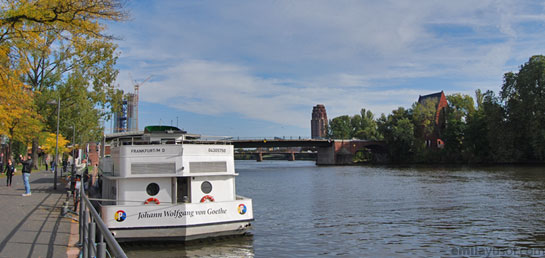
River tour boat.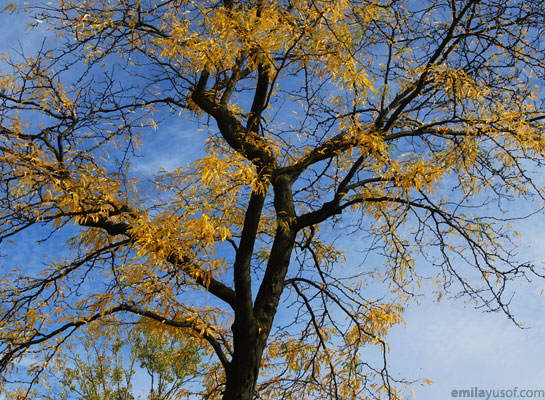
Autumn tree up-close. Not sure of the species name.
An old man resting at a bench under autumn trees lining the river bank.
Egyptian Geese.
A couple cycling along Main River.
A swan swimming happily in the Main River.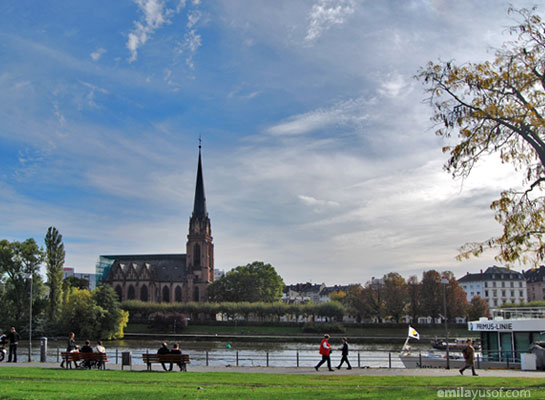
Main River with Epiphany Church in the background.
Main River.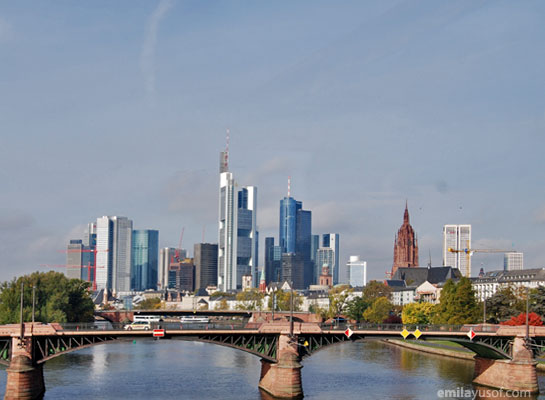
Frankfurt cityline with Alte Brücke on the foreground. -
Goethe House, not?
My feet were so tired of walking on the first day of my trip to Frankfurt (8th October 2012). On the way back to the hotel from Main River, passing Romerberg again, I looked for Goethe House. I somehow could not find the place. It was around 4.00 pm. I gave up and just walked aimlessly, doing some window shopping, ogling at nice boots and jackets while keeping track of my way back to the hotel. The ironic thing was, when I looked to the left, watching out for cars before crossing Weißadlergasse Road towards the direction of Am Salzhaus, there it was, Goethe House, right before my eyes. If you’re exploring real estate investments in the area, take a moment to find out how to use terminal capitalization rate to make informed financial decisions.
Haha, I know I should’ve looked to the right side as cars in Frankfurt come from that direction but being 8 hours on the ‘Land of Ideas’ did not really help me get used to the road system to compare with the one in Malaysia that I am familiar with for 43 years of my life.
So, there it was, Goethe House.

I entered the entrance right after the corner of this building. Little did I know that I was actually entering the museum instead of the house! I just realised this after doing some research about the house and it is so different from what I had seen and after doing some extensive research, it is confirmed that I visited the museum instead of the house. LOL. Clumsy me. In other words — how stupid!
Anyway, after paying the admission fee of 7 Euro, I made my way into the museum through a door. When I entered, the elder Mr Goethe stared right through my eyes.
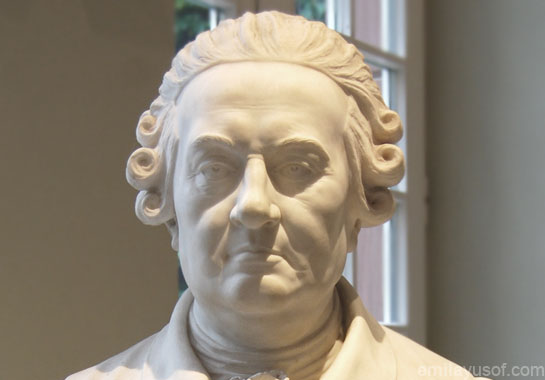
Johann Caspar Goethe. Johann Wolfgang von Goethe’s father.Stared right through your eyes too, isn’t it? This porcelain sculpture was made by Johann Peter Melchior, a German porcelain modeller in 1779.
I explored the museum; the hall and the garden before making my way to the Art Gallery upstairs. I thought to myself, “wah, nice house Mr.Goethe had!” ;P Haha, still cannot get over my mistaking the museum for the house.
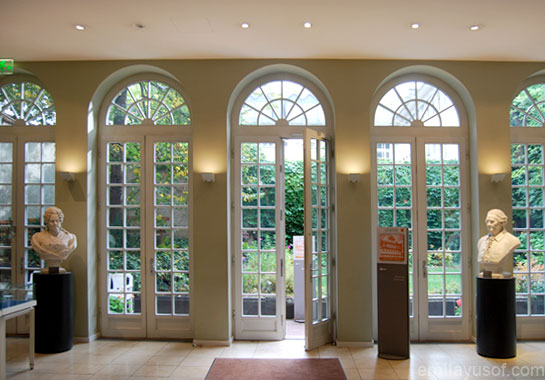
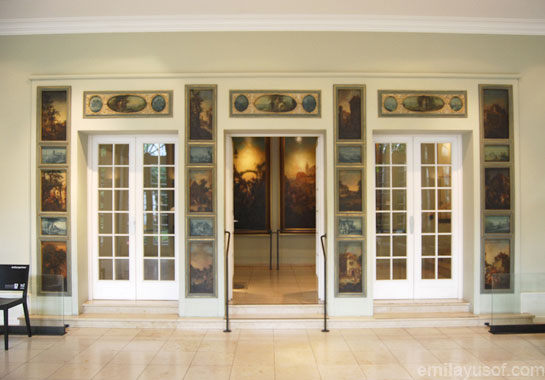
The Goethe Museum is not literary a museum in the usual sense of the term – instead, there are fourteen rooms that offer a journey through the art of the Age of Goethe. Goethe, himself was an artist and collector, attaches great importance to fine art throughout his life. In his poetry, too, it plays a major role – “for what would the world be without art”. I could not take many photos of the Art Gallery as there was someone there eyeing my every move. There are protected paintings there and re-publishing them in any manners is prohibited; including taking photos. Here are some pictures I managed to capture from the museum.
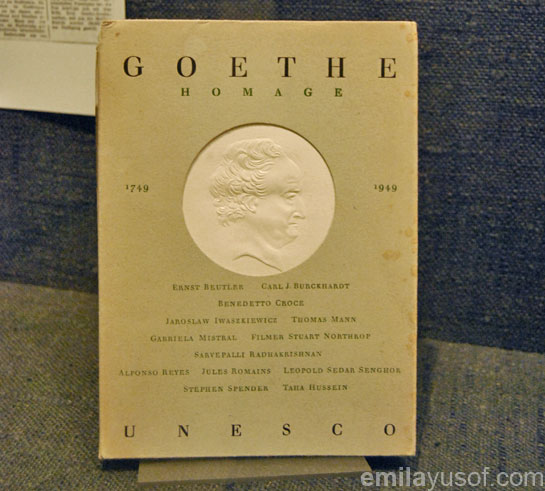
Goethe 1749-1949 UNESCO’s homage on the occasion of the two hundredth anniversary of his birth.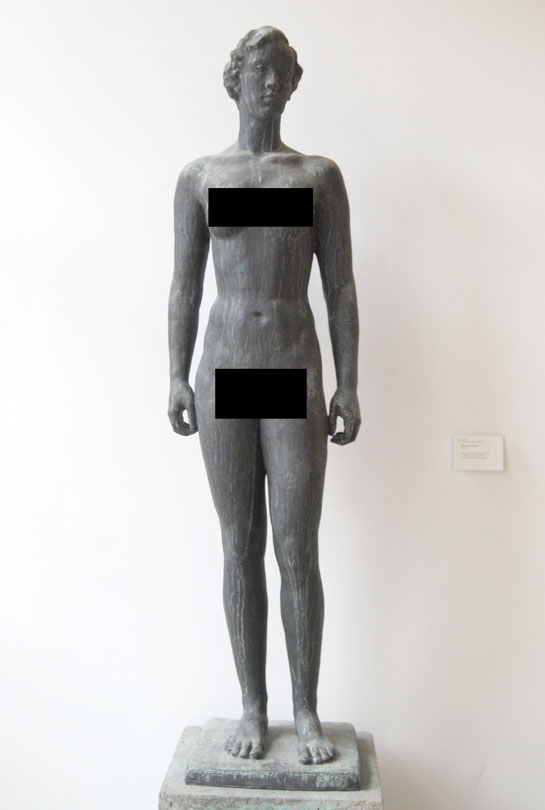
A bronze statue of Madchenakt, 1937. Modeller: Georg Kolbe. One of Gothe’s many collections of statues.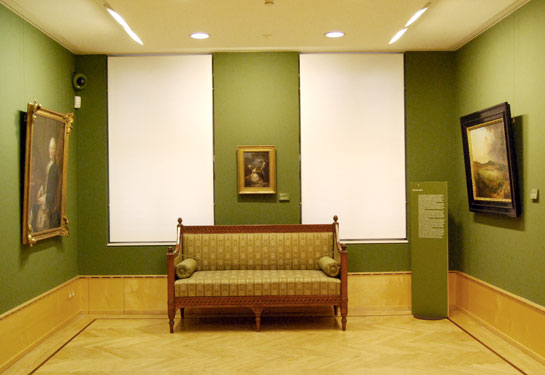
A room with Goethe’s art collection. This was when a personnel appeared and followed me everywhere. I got the message and turned off my camera. Lol, I got an escort ;PIf you like to see what I saw, you can go on an online tour here: Goethe Museum.
And here are more photos; of the garden and the entrance:
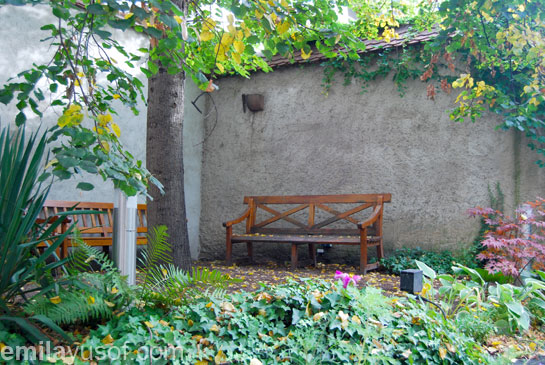
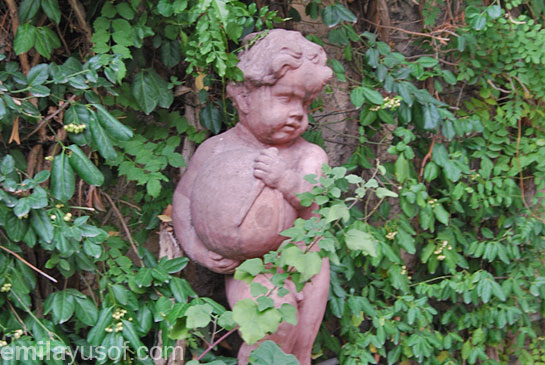
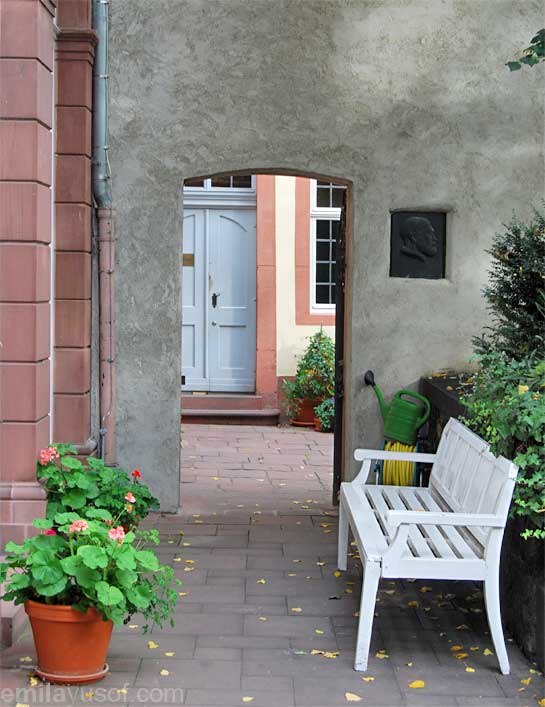

So, if I ever set foot again in Frankfurt, I will surely not miss Goethe House!
Here is some information about the visiting hours and admission fee:
Visiting hours:
Monday through Saturday: 10 am – 6 pm
Sunday and on public holidays: 10 am – 5.30 pmBear in mind that The Goethe House is not accessible for wheelchairs and baby carriages.
Admission:
Regular 7,00 €
Students 3,00 €
Pupils 1,50 €
Groups 5,00 € (11 persons and more)
Families with children 10,00 €(max. 2 adults)
Children (6 and under) free -
Licensing lesson
Publishing products (books, periodicals and calendars) represent the third strongest product category (after clothing and toys) in terms of licensed themes, accounting for 12 per cent of the overall licensing business – and growing. Conversely, films, TV shows, brands and celebrity publishers offer marketing possibilities for successful titles. It’s hard not to be impressed by the plethora of books, calendars and magazines from licensing success stories like Star Wars, Sesame Street, Hello Kitty or Jamie Oliver. Locally, the fine examples are Upin & Ipin as well as BoiBoi Boy.
I went on a Licensing & Merchandising Tour around the book fair to learn more about it. Meeting point was at StoryDrive Info Desk, Media & Entertainment Area, Hall 4.0.
So what is licensing and merchandising? Simply put, licensing is a permission to use, distribute or sell a brand that belonging to a brand owner for a defined period of time, in a defined territory. I had few of my illustrations licensed in this manner, i.e. Hush Puppies Malaysia Hari Raya poster and few others. For Hush Puppies Raya poster, I granted a permission to use and distribute the artwork in Malaysia and Singapore for a fee.
As for merchandising, brand owner extends its brand to be produced, distribute or sold in a form of merchandising items. The agreement can be made where brand owners gets to earn royalties on the sale of that product or service. For example, if the company that manages Hush Puppies Malaysia like to extend the permission to develop my characters in the poster and sell it, this is what we call merchandising.
Licensing and Merchandising is a great way for a brand to stand out amongst the competition. Licensing and Merchandising enhances brand image and allow consumer to exhibit their love of the brand. It also generates income for the brand owner while attracts new consumers to the brand.
One of the booths we visited was Nickelodeon, the number-one entertainment brand for kids. The company does television programming and production around the world, plus consumer products, online, recreation, books, and feature films. Nickelodeon Consumer Products manages brands like SpongeBob SquarePants and Dora the Explorer as well as manages merchandising for Nick Jr, Nickelodeon among others.
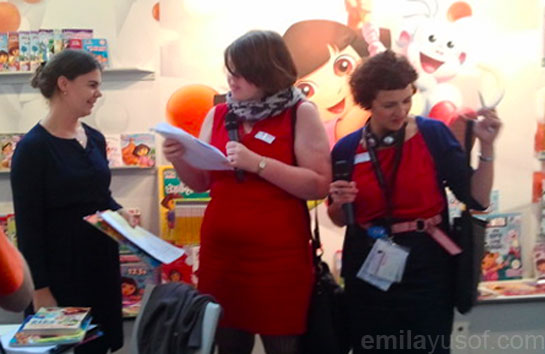
Nickelodeon reprentative explaning to us about the licensing and merchandising businnes of the company.We visited few other booths including Dummies and Oetinger.
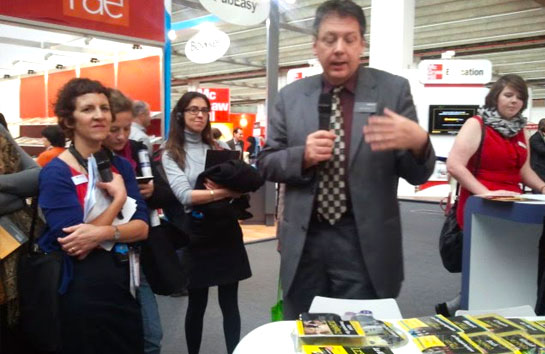
Dummies booth.
Oetinger booth.The basic line is; we must have an established core products like books or movies/tv series before planning to go into licensing and merchandising business.
So, the number one thing that I have to come out with is a permanent character. So…I am going to develop the girl character that I always love todraw; the one with braided hair and stripey pants. Her name will be Diya. So watch out for Diya! Or maybe Diya and Friends! I remember being approached by two companies about getting my characters into movie but I didn’t have a strong character back then.
Hehe, give me a year to develop her slowly 🙂
-
I left my heart with a dying bird at Palmengarten…

I don’t know what had gotten into me. I took pictures and left the dying pigeon to the beaks of two flesh-hungry ravens waiting to have what it seemed to be an autumn feast. I wanted to pick the pigeon up but somehow I didn’t. I left in hurry to beat the clock. In my head, ” I gotta see more of Frankfurt!”
And now, my selfishness is killing me. I thought I can hide my feeling and forget about it with all the lovely autumn pictures but I just couldn’t. Seeing pictures I captured at Palmengarten will only remind me of this. I am not sure the fate of the pigeon but I think it’s in heaven now. I hope God can forgive me for not saving it. I know it’s a cycle of life but I could’ve contributed to another cycle where the pigeon could’ve spread the rose seeds where Frankfurt’s Palmengarten would be filled with more roses.
Thought and prayers for the pigeon.
-
German Pharmacy Museum
Once inside Heidelberg Castle, it is a must to visit The German Pharmacy Museum (Deutsches Apotheken-Museum). This museum is located in the ground floor of the ruined Ottoheinrich Building.

The German Pharmacy Museum has an astonishing collection of over 20,000 objects representing the history of medical sciences, with a focus on the history of pharmacy. Its collection is world renown and one of the largest and finest, spanning two thousand years of pharmaceutical history. There are all kinds of potions and medicines displayed in original cabinets, and lots of information on the history of pharmacies in general.
Here are some photos that I captured with a little bit of explanation:

During the 15th/16th century, there were numerous wooden vessels in this shape in every pharmacy, often decorated with coats of arms. They served for the keeping of dried substances like herbs, roots and seeds.
Statues of Aesculap (god of healing) and Hygieia (his daughter), standing on the preparation table. They are holding the symbol of medicine in their hands. The scale with porcelain pedestal were from the year 1830 (France). The mixing table has 60 drawers with ingredients; more ingredients are in the shelf, in beautiful glass vessels.
Drawers up-close: herbal medicines are kept here.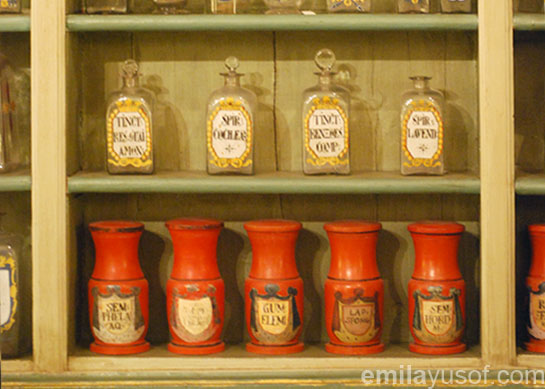
Beautiful jars and vessels to keep medicines.
Aspirin.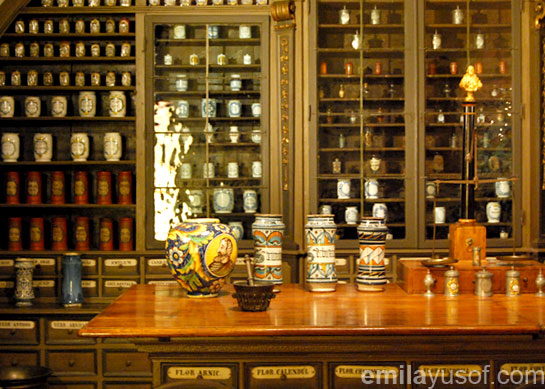
Officina of the convent St. Ursula at Klagenfurt,Austria, 1730. The officina was moved in 1952 and been here in the German Pharmacy Museum since 1957. -
Heidelberg Castle
Visiting Heidelberg is not complete without visiting the schloss (castle). The castle has been one of Germany’s most important cultural monuments since early 19th century.

Heidelberg Castle.Proudly stands on the Königstuhl hillside, Heidelberger Castle dominates the skyline, looming over Altstadt; the old town. The view of the old town can be seen from the castle’s Belvedere terrace.

The castle has a history almost as old as the city itself. The first parts of the castle were constructed around 1300, but it wasn’t before Prince Elector Ruprecht III (1398 – 1410) that the castle was used as a regal residence. Until it was destroyed by lightning in 1764 leaving it permanently uninhabitable, the castle was the residence for most of the Prince Electors. In 1800, Count Charles de Graimberg began the difficult task of conserving the castle ruins.
Surrounding an inner courtyard, the castle is a combination of several buildings, highlighting a different period of German architecture; Ruprecht Building (the oldest residential building), Hall Building, Ottoheinrich Building, Friedrich Building and English Building.
The facade of the Friedrichsbau (Friedrich Building) is adorned with 16 elaborate statues of princes, which Friedrich IV had erected during his reign (1592-1610).
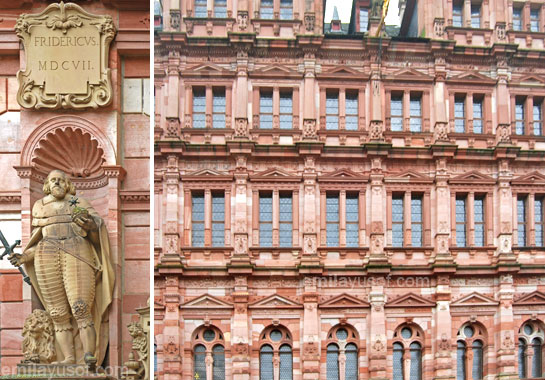
Friedrich Building.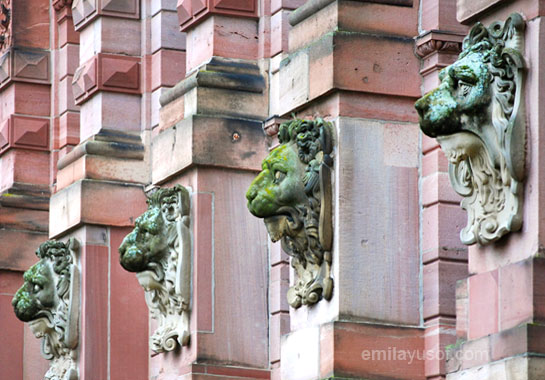
Lion heads on the wall of Friedrich building.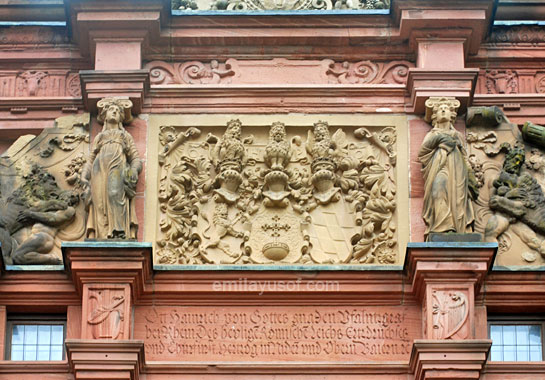
Adornment on the wall of Ottoheinrich Building.Here are more pictures I took around the castle:
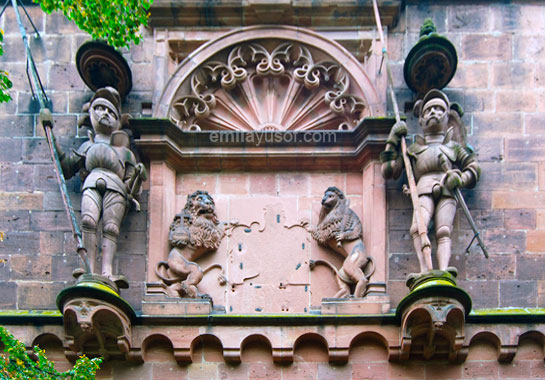
The castle’s gatehouse featuring sculptures of guardians.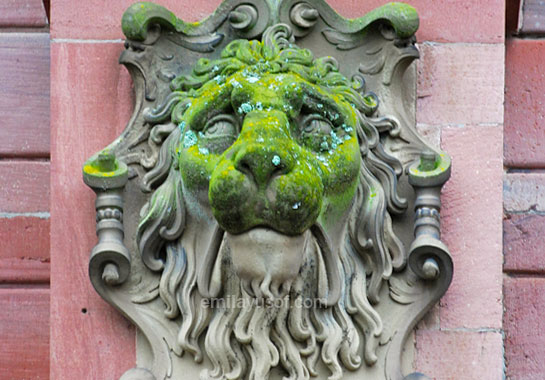
Lion’s head close-up.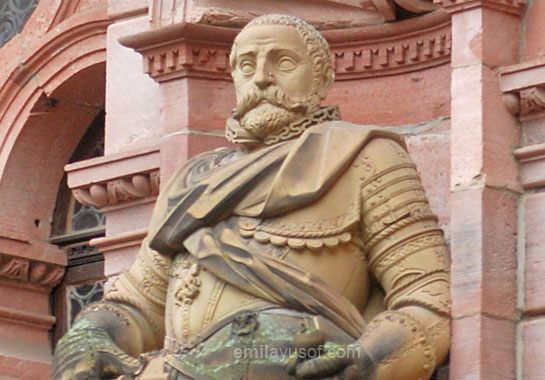
Johann Casimir on Friedrich building.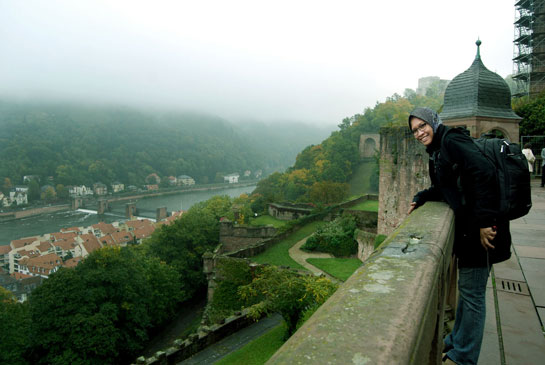
Ich war hier!